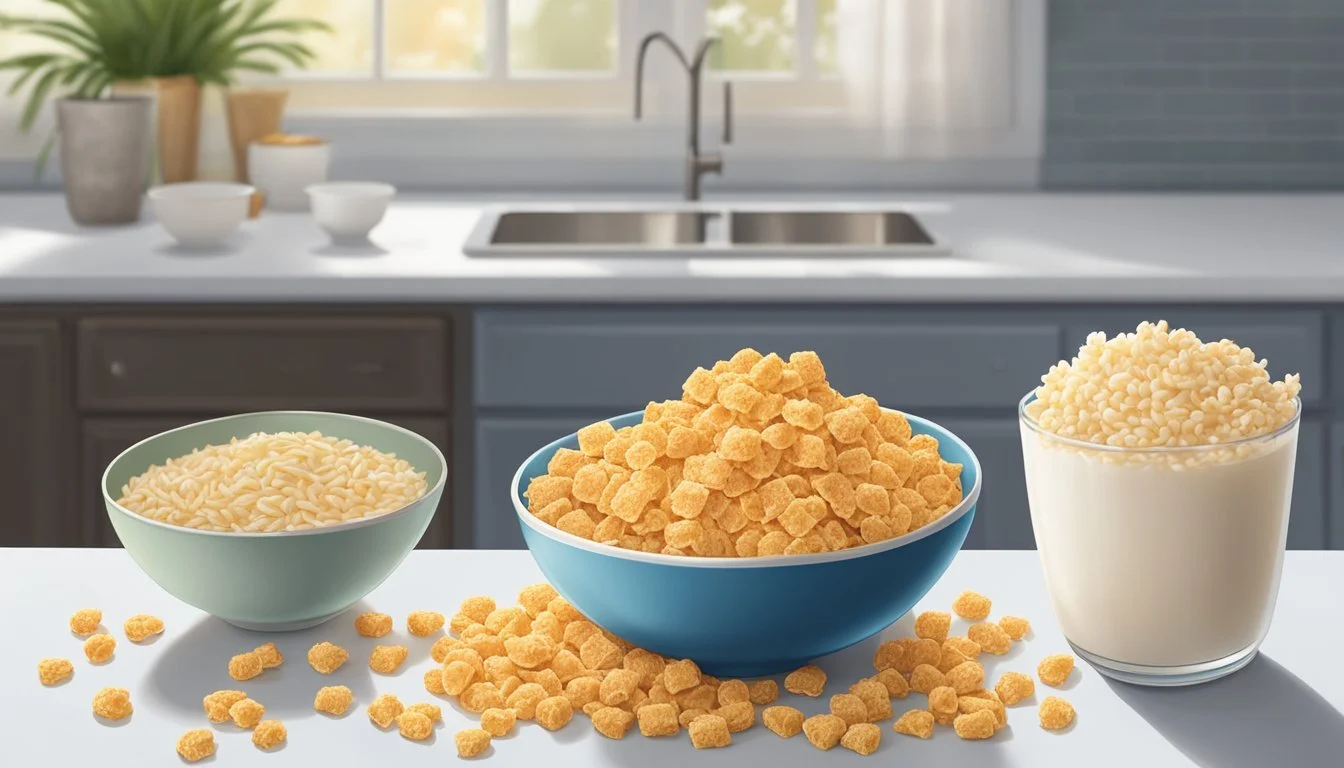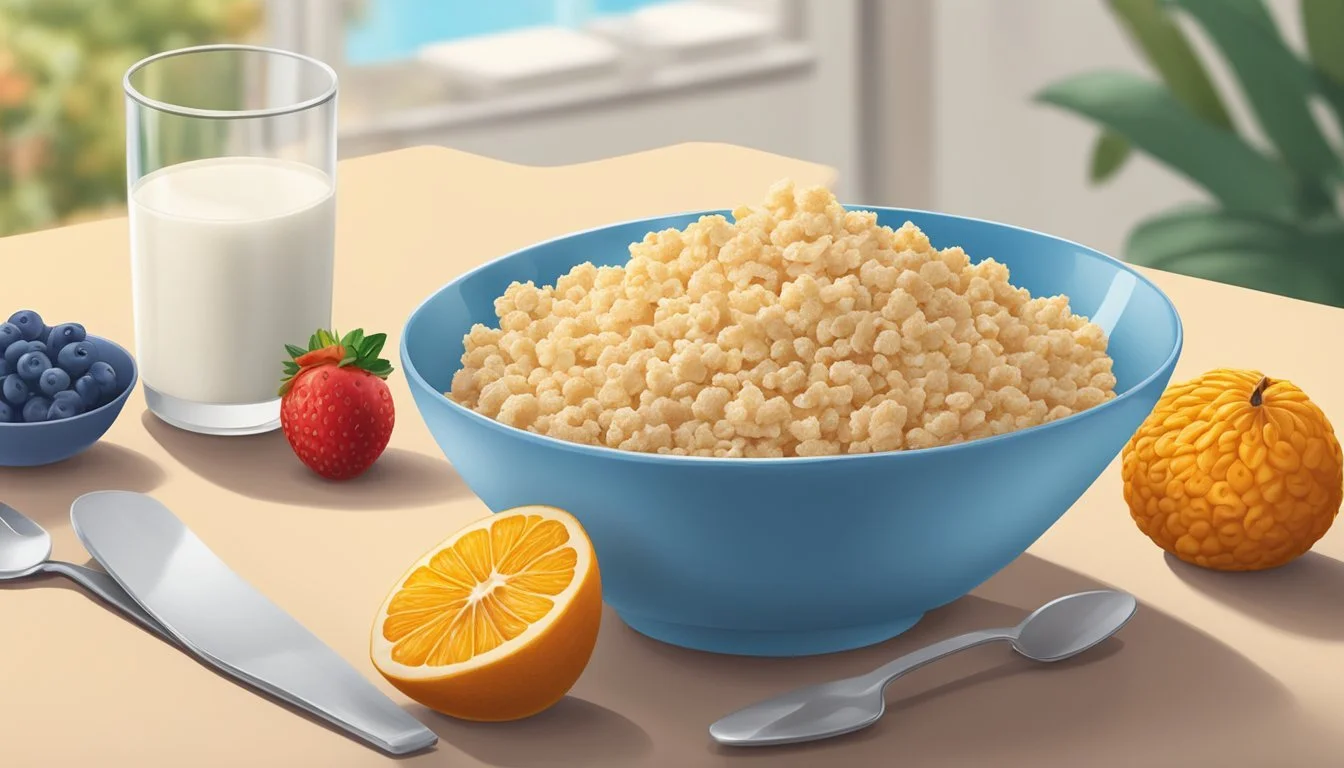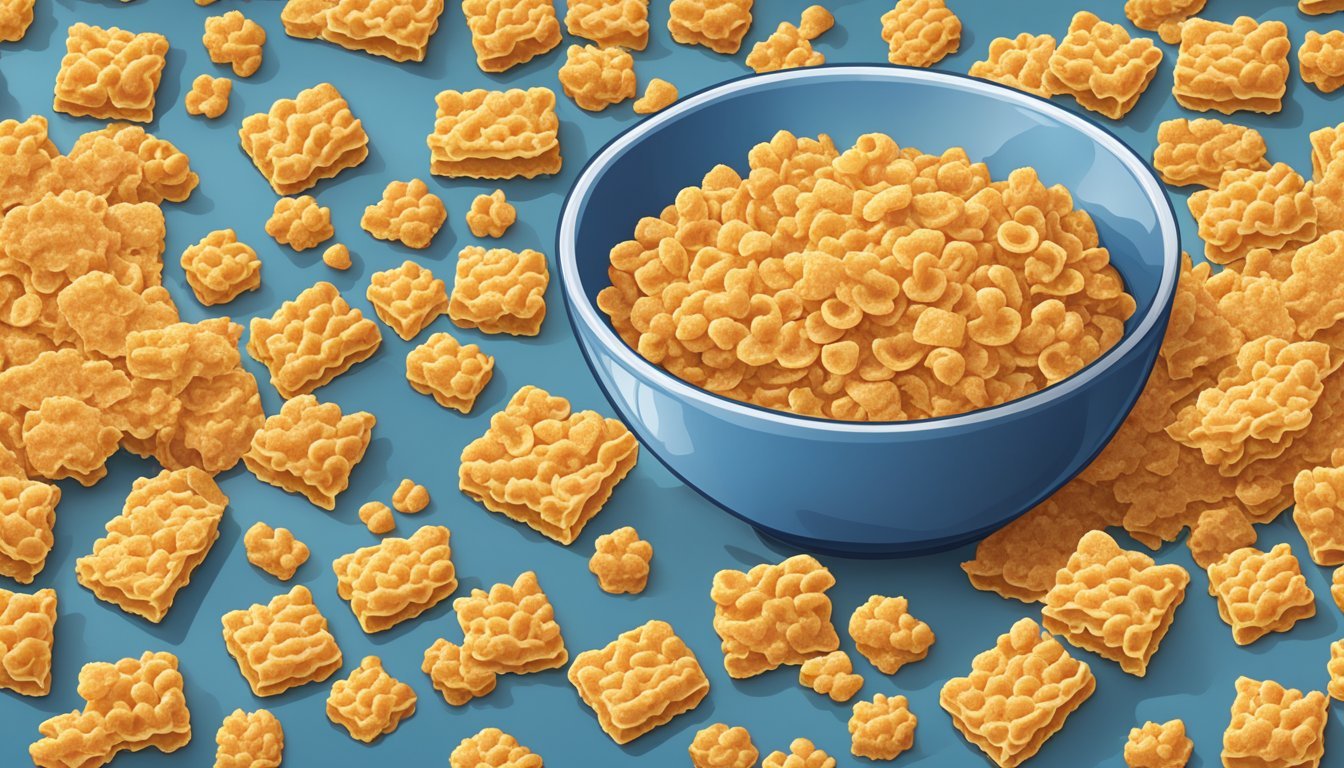Frosted Flakes vs Rice Krispies
Nutritional Comparison and Flavor Profile
This Article is Part of Our Breakfast Cereal Guide with Details on Frosted Flakes Nutrition and Rice Krispies Nutrition
When it comes to choosing between Frosted Flakes and Rice Krispies for breakfast, there are several key nutritional differences to consider. Frosted Flakes, known for their sugary coating, offer less complex carbohydrates than Rice Krispies, with 14.0 grams per serving compared to Rice Krispies’ 22.0 grams. Frosted Flakes also provide significantly more iron, making them a potentially better option for those looking to boost their iron intake.
One of the most striking contrasts between these cereals lies in their sugar content. Frosted Flakes contain more sugar per serving, appealing to those with a sweet tooth but raising concerns for those mindful of their sugar consumption. On the other hand, Rice Krispies, with their lower sugar content, may be a better fit for those seeking a less sweet and potentially healthier option.
Both cereals offer unique nutritional benefits and drawbacks. Ultimately, the choice may come down to dietary goals and personal preferences.
Historical Background and Manufacturers
Kellogg's is a key player in the breakfast cereal market, producing classics like Frosted Flakes and Rice Krispies. Understanding their origins can provide insight into their long-standing popularity.
Origin of Frosted Flakes
Kellogg's Frosted Flakes were introduced in 1952 as a sweetened version of their popular Corn Flakes. The cereal features sugar-coated corn flakes, making it an instant hit among children and adults alike.
Tony the Tiger, the cereal's mascot, famously popularized the catchphrase "They're Grrrreat!" The character has been instrumental in building the brand's identity and remains a recognizable figure in advertising today.
Initially branded as "Sugar Frosted Flakes," the name was later shortened to Frosted Flakes. This change reflected a broader trend in the industry to downplay the focus on sugar. Frosted Flakes remain a staple in many households and have expanded into various markets across the globe under different names, such as Frosties in the UK.
Origin of Rice Krispies
Kellogg's Rice Krispies debuted in 1928, introducing a new type of breakfast cereal made from puffed rice. This innovation was part of Kellogg’s drive to create lighter, healthier breakfast options.
The cereal's unique sound — the iconic "snap, crackle, and pop" — became a significant marketing point. Characters named Snap, Crackle, and Pop were created to personify these sounds and have featured prominently in advertisements for decades.
Initially targeted at children, Rice Krispies quickly gained popularity among adults as well. The cereal’s versatility also extends to recipes, particularly Rice Krispies Treats, which have become a beloved homemade snack. The brand has continuously adapted, releasing variations like Cocoa Krispies and Rice Krispies Multigrain Shapes to cater to evolving consumer preferences.
Nutritional Profile Comparison
Frosted Flakes and Rice Krispies may appear similar at first glance, but their nutritional compositions reveal distinct differences. This comparison examines key elements such as calories, macronutrients, vitamins, minerals, sugar, sodium, and fiber content.
Calories and Macronutrients
Frosted Flakes contain approximately 110 calories per serving, while Rice Krispies have around 100 calories per serving. Both cereals are relatively low in fat, with Frosted Flakes at 0.5 grams of fat per serving and Rice Krispies at just 0.1 grams.
Protein content:
Frosted Flakes: 1 gram per serving
Rice Krispies: 2 grams per serving
Carbohydrates:
Frosted Flakes: 26 grams per serving, including 14 grams of complex carbohydrates
Rice Krispies: 23 grams per serving, including 22 grams of complex carbohydrates
Vitamins and Minerals Content
Frosted Flakes are more fortified with vitamins and minerals compared to Rice Krispies.
Iron: Frosted Flakes provide 25% of the daily value (DV), whereas Rice Krispies offer 10%.
Vitamins:
Frosted Flakes: Vitamins B6, B12, B3, B1, B2, Folate, and Vitamin D
Rice Krispies: Lesser amounts of similar vitamins
Frosted Flakes have higher Vitamin B6, B12, and D levels, making them richer in these essential nutrients.
Sugar and Sodium Levels
Frosted Flakes have a significantly higher sugar content, with 10 grams of sugars per serving compared to less than 1 gram in Rice Krispies.
Sodium content:
Frosted Flakes: 150 milligrams per serving
Rice Krispies: 190 milligrams per serving
While Frosted Flakes are more sugary, Rice Krispies have a higher sodium level, which is something to consider depending on dietary needs.
Fiber Content Analysis
Frosted Flakes provide about 1 gram of dietary fiber per serving, contributing to daily fiber requirements. Rice Krispies, being more bland, offer a slightly lower fiber content, around 0.2 grams per serving.
For those looking to boost their fiber intake, Frosted Flakes might be the better option. However, additional sources of fiber might still be necessary to meet daily intake recommendations.
Ingredient Breakdown
Frosted Flakes and Rice Krispies each have distinct ingredient profiles that contribute to their nutritional differences. The following subsections will explore the key ingredients in each cereal and their nutritional implications.
Key Ingredients of Frosted Flakes
Frosted Flakes' primary ingredient is corn, a common base for many cereals. This cereal is fortified with several essential vitamins and minerals.
Iron content is notably high, covering a significant portion of daily needs. It also contains Vitamin B6, B12, D, C, B1, B2, B3, and folate. These additions aim to enhance nutritional value.
Sugar is a prominent ingredient, giving Frosted Flakes their characteristic sweetness. This can be a concern for those monitoring sugar intake.
Other ingredients include malt flavoring, which adds to the taste, and small amounts of salt, enhancing flavor.
Key Ingredients of Rice Krispies
Rice Krispies are primarily made from rice, contributing to a different nutritional profile compared to corn-based cereals.
This cereal also undergoes fortification with essential nutrients. Like Frosted Flakes, Rice Krispies contain Iron, Vitamin B6, B12, D, B1, B2, B3, and folate. Though it offers similar vitamins and minerals, the overall texture and taste are quite distinct.
Rice Krispies have a lower sugar content than Frosted Flakes, making them a potentially better option for those needing to minimize sugar.
Additionally, ingredients like salt and malt flavoring are included to enhance palatability. Rice Krispies are generally simpler in their ingredient list, focusing more on the natural taste of the rice.
Health and Diet Considerations
When comparing Frosted Flakes and Rice Krispies, various health and diet factors need to be considered. These include the suitability of each cereal for different dietary needs, their impact on blood sugar levels, and their role in weight management.
Suitability for Various Diets
Frosted Flakes and Rice Krispies differ in their compatibility with various diets. Rice Krispies has 22 grams of complex carbohydrates per serving, making it less suitable for low-carb diets compared to Frosted Flakes with 14 grams of complex carbohydrates. Neither Frosted Flakes nor Rice Krispies contain significant amounts of saturated fats or trans fats, which is beneficial for those on low-fat diets.
For individuals on a low-sugar diet, Rice Krispies generally have less added sugar compared to the sweetened Frosted Flakes. However, both cereals are not ideal for those needing high fiber intake, as they contain minimal fiber content. Neither cereal is gluten-free, which excludes them from being suitable for individuals with gluten intolerance or Celiac disease.
Impact on Blood Sugar
The glycemic index (GI) is a critical factor in determining a cereal's impact on blood sugar levels. Frosted Flakes, with higher sugar content, can cause a more rapid spike in blood glucose levels compared to Rice Krispies. Rice Krispies, although high in complex carbohydrates, typically have a lower GI than Frosted Flakes, making them slightly better for managing blood sugar levels.
Individuals with diabetes or those monitoring their blood sugar should be particularly cautious with Frosted Flakes due to their higher sugar content. It's essential to pair these cereals with protein or healthy fats to slow down sugar absorption and mitigate blood sugar spikes.
Role in Weight Management
When it comes to weight management, both cereals have unique considerations. Frosted Flakes, despite being sweet, are lower in complex carbohydrates compared to Rice Krispies, which may aid those on a calorie-counting regimen. Rice Krispies, with their higher carbohydrate content, may provide more sustained energy, useful for maintaining an active lifestyle.
Neither cereal is high in fiber, a crucial nutrient for promoting fullness and reducing overall caloric intake. Moreover, the lower calorie content per serving in Rice Krispies may benefit those aiming for weight loss, as they can consume a larger portion without consuming excess calories.
Both cereals are fortified with various vitamins and minerals, contributing to daily nutritional needs, although these additions don't significantly impact weight management.
Flavor and Texture Profiles
The exploration of both cereals reveals distinct taste experiences and textures. Each cereal offers unique characteristics that cater to different preferences.
Taste Experience of Frosted Flakes
Frosted Flakes are known for their sweetness and crisp texture. The corn flakes are lightly coated with sugar, providing a sugary taste that is especially appealing to those who enjoy sweeter cereals.
Upon opening a box of Frosted Flakes, an aroma of sugar and corn is immediately noticeable. When combined with milk, the sweetness of the flakes becomes slightly muted, allowing a more balanced flavor. Over time, the flakes soften but still retain some crunch, making for an engaging texture change as one eats.
The balance of sweetness and the toasty flavor of corn makes Frosted Flakes a nostalgic and delightful option for many.
Taste Experience of Rice Krispies
Rice Krispies stand out for their crispy and airy texture, derived from the puffed rice grains. Unlike Frosted Flakes, Rice Krispies have a much milder sweetness, offering a subtler flavor profile.
When dry, the cereal produces a distinctive "snap, crackle, and pop" sound when milk is added, enhancing the eating experience. The texture remains light and crispy initially but softens quickly, absorbing the milk and transforming into a softer, albeit still pleasing consistency.
Rice Krispies are versatile in that they serve not only as a breakfast cereal but also as a base for various sweet treats. The neutral flavor allows them to pair well with additions like fruits or nuts, making them a favorite for creative culinary uses.
Consumer Information
Kellogg's Frosted Flakes and Kellogg's Rice Krispies are both popular breakfast cereals, but differ in serving size preferences, availability in stores, and pricing.
Serving Sizes and Recommendations
Kellogg's Frosted Flakes typically recommends a serving size of ¾ cup (29 grams), containing 110 calories. This serving size includes 14 grams of complex carbohydrates, of which 10 grams are sugars.
In contrast, Kellogg's Rice Krispies suggest a serving size of 1 cup (28 grams), providing 120 calories. Rice Krispies contain 22 grams of complex carbohydrates with only 4 grams of sugars, making them a preferable choice for those monitoring sugar intake.
Nutritional Comparison:
Cereal Serving Size Calories Carbohydrates Sugars Frosted Flakes ¾ cup (29g) 110 14g 10g Rice Krispies 1 cup (28g) 120 22g 4g
These recommendations help consumers make informed dietary choices based on their health needs.
Availability and Purchase Locations
Frosted Flakes and Rice Krispies can be found in most major grocery stores, including Walmart, Target, Kroger, and Safeway. They are often stocked in the breakfast cereal aisle and available in various packaging sizes, from single-serving boxes to family-sized packages.
Additionally, both cereals can be purchased online through platforms such as Amazon, Walmart’s online store, and grocery delivery services like Instacart. This widespread availability ensures convenient access for consumers regardless of their preference for in-store or online shopping.
Seasonal promotions and store-specific deals might influence availability, so checking local stores or online listings can help in finding the most convenient purchasing option.
Price Comparison
The price of Frosted Flakes and Rice Krispies can vary depending on the store, packaging size, and location. On average, a 24-ounce box of Frosted Flakes costs around $3.99 to $4.99, while a 12-ounce box generally costs about $2.99 to $3.99.
Rice Krispies, in a 22-ounce box, are typically priced at $3.49 to $4.49, with smaller 12-ounce boxes costing around $2.79 to $3.79. Prices may be influenced by factors such as store promotions, brand loyalty programs, and bulk purchasing discounts.
Consumers looking for the best value should consider comparing prices across different stores and online platforms. Membership clubs like Costco and Sam's Club sometimes offer larger packages at reduced prices, which can be cost-effective for families.
Market Alternatives
In considering alternatives to Frosted Flakes and Rice Krispies, it’s essential to examine the strengths and features of competitive products within the cereal market. Notable brands offer unique benefits and flavor profiles, catering to a variety of preferences and nutritional needs.
Similar Products Comparison
Cheerios and Honey Nut Cheerios: These are popular options that appeal to those looking for heart-healthy cereals. Cheerios offer a simple, lightly sweetened oat taste, while Honey Nut Cheerios add a hint of honey and almond flavor.
Raisin Bran and Kellogg's Raisin Bran: Both provide added benefits with the inclusion of raisins, promoting digestive health. Kellogg's Raisin Bran often includes more raisins and a slightly sweeter taste compared to Post Raisin Bran.
Special K and Total: These cereals target health-conscious consumers, focusing on vitamins and minerals without compromising taste. Total is known for its comprehensive nutritional profile, while Special K is often associated with weight management.
Honey Bunches of Oats and its variants: This includes options like Honey Bunches of Oats with Almonds, which offer a blend of crunchy oats, cornflakes, and nuts, providing variety in texture and taste.
Fruity Pebbles and Lucky Charms: Designed for those who prefer sweeter, more colorful cereals, offering a fun and vibrant breakfast experience. Both are great for marshmallow lovers and those seeking a nostalgic treat.
Fiber One and Shredded Wheat: These focus on higher fiber content, making them ideal for those needing digestive health support. Shredded Wheat offers a no-sugar-added option, appealing to the health-conscious.
Wheaties: Known as the "Breakfast of Champions," it appeals to athletes and those seeking a balanced start to their day with whole grains.
Golden Grahams and Corn Chex: These cereals provide unique flavors and textures. Golden Grahams offer a graham cracker taste, while Corn Chex provides a versatile option that can be used in various recipes.
Each of these alternatives holds its unique place in the market, catering to different taste preferences and nutritional needs.





